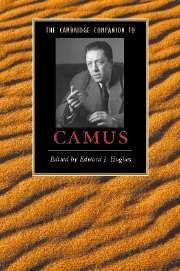Introduction
Published online by Cambridge University Press: 28 September 2007
Summary
Albert Camus was a writer who emerged from social obscurity to become a best-selling author and post-war icon in France and beyond, winning the Nobel Prize for literature in 1957. His premature death in January 1960 - he and the publisher Michel Gallimard were killed in a car crash at Villeblevin, south of Paris - did nothing to diminish that iconic status. Yet behind this tidy, poverty-to-celebrity-to-tragedy narrative, a more complex life story and body of writing beckon. In his Nobel acceptance speech at Stockholm in December 1957, he points out that his life story is part of the collective history of his generation, which has lived through 'une histoire démentielle' ('an insane history'), one that has had to contend with 'le mouvement destructeur de l'histoire' (Ess, 1072, 1074) ('the destructive movement of history'). Born on the eve of the First World War, Camus continues, he and his contemporaries reached adulthood as Hitler obtained power and as the first of the revolutionary trials got under way in the Soviet Union. And just to round off the education of his generation, a string of confrontations follow - with civil war in Spain, the Second World War and the concentration camps. Meanwhile the children of this generation face the spectre of nuclear destruction. Camus's conclusion is that a death instinct is at work in the collective history of his times as tyranny's 'grands inquisiteurs' (Ess, 1073) ('grand inquisitors') hold sway.
- Type
- Chapter
- Information
- The Cambridge Companion to Camus , pp. 1 - 10Publisher: Cambridge University PressPrint publication year: 2007



